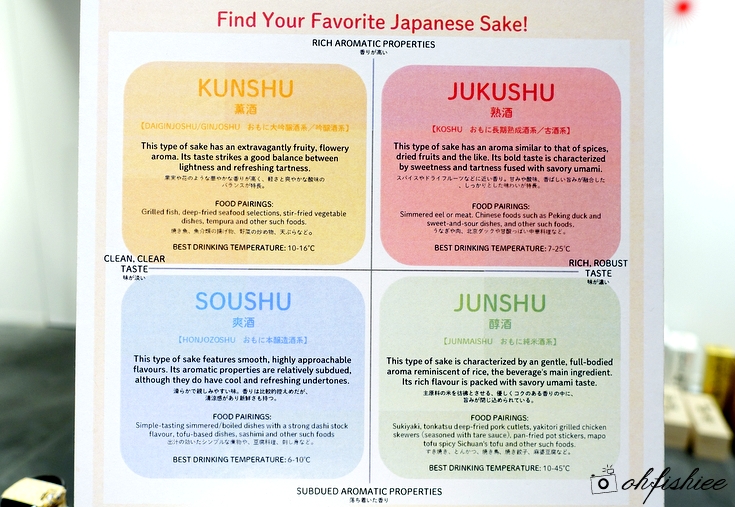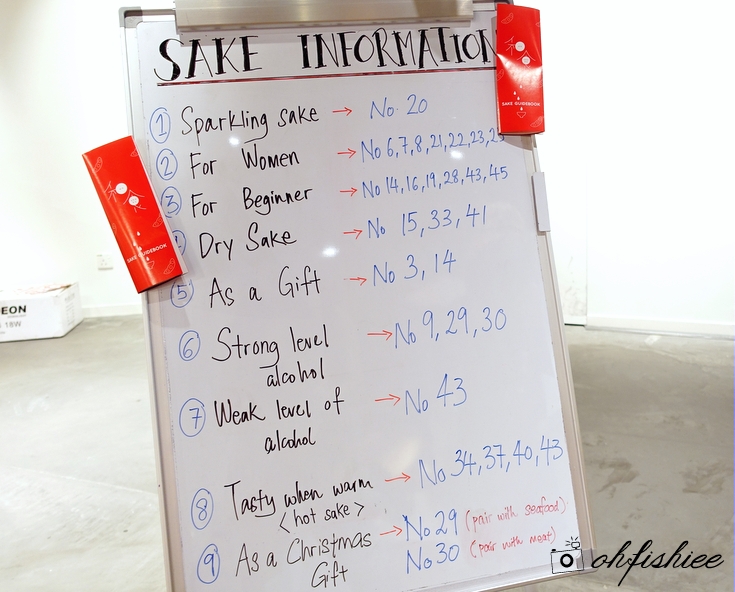Kanpai! 乾杯! Cheers! Let's toss with the Japanese saké at the Washoku: Japanese Food for Festivities fair!
In conjunction with the first anniversary of ISETAN The Japan Store Kuala Lumpur, Washoku: Japanese Food for Festivities is organised by Dai Nippon Printing Co., Ltd at The Cube, 3rd floor of ISETAN from 25 October 2017 till 25 January 2017 to bring us the best of Japan. From Japanese delicacies and sake to the cultural workshop, the Washoku fair is something for you Japan lovers without having to travel too far.
Currently, the Washoku fair features 45 types of saké from 9 areas in Japan which are not commonly found in Malaysia. The prefectures include Kyushu, Shikoku, Chugoku, Kinki, Chubu, Kanto, Tohoku, Chubu and Hokkaido.
Here I learn something valuable about the art of brewing saké. The higher is the rice milling rate (the more the rice is polished off), the more rice is required to make the saké, therefore the more expensive the saké is.
So whenever you purchase a saké, remember to look for its "polishing rate" on its label --
The lower is the polishing rate, the higher is the grade of the saké.
Here are some simple guidelines that distinguish the aroma and taste of sake.
The saké made with the more highly polished rice is certainly cleaner and more refined, hence more expensive. Each bottle of saké is labelled with the rice polishing ratio and alcohol content, so we get to understand what we drink better.
If you really do not know which to choose, you can always consult the helpful and knowledgeable staff here. Or simply refer to the guide to find out which saké suits your palate the most.
Here you can taste and try the saké as much as you can!
The price ranges from RM5 to RM20 per cup of saké, and you may bring along your friends and family to share a saké flight set of 3 cups at only RM20 per set. The best part is, you can come and enjoy a special HAPPY HOUR Promotion during weekday -- 20% OFF for 5 cups of saké and above (excluding saké flights).
From left to right:
No. 30 Cowboy Yamahai
No. 29 Fisherman Sokujo Deep
No. 28 Suzukagawa Junmaidaiginjo
For instance, there are several types of saké from Chubu, the center of Japan's largest island Honshu, and you can try 3 of them in a saké flight. Cowboy Yamahai is best paired with meat because of its slightly high alcohol level that balances up the meat flavours where Fisherman Sokujo Deep's fruit flavour and light sweetness pair well with seafood such as fresh crab and shrimp.
From left to right:
No. 23 Kunizakari Rose Umeshu
No. 22 Kunizakari Obaachan No Yuzushu
No. 21 Kunizakari Kocha Umeshu
Also from Chubu, here are some options for those who prefer something sweet. Umeshu is a type of sweet-sourish plum wine that has been infused with other ingredients for more distinctive tastes, whereas Yuzushu is an aromatic highly-prized yuzu saké made from domestically produced yuzu. Ladies would definitely love them!
Do you know that the sweet umeshu is ideally consumed at a chilled condition of 10°C to 15 °C?
At this temperature, it would taste more refreshing, less cloying and you just can't resist another cup.
Tips to drink: Take out from fridge, leave at room temperature for 5 minutes then it is ready to drink.
If you are looking for gifts, try No. 14 Ayakiku Junmaidaiginjo from Shikoku,
an elegant saké with 15% alcohol content and a very clear taste on the palate.
No. 24 Morita Owari Otokoyama from Chubu is also recommended for its mellow taste, high-quality sterile brewing process, pure and clear fragrance, and rich composition of amino acids and vitamins that help protect the heart and blood vessels.
Here are the 5 saké I get to try here, in ascending order in terms of smoothness, clarity and price:
#1 No. 16 Hyogo Otokoyama
#2 No. 20 Tsukinokatsura Daiginjo Nakagumi Honjozo
#3 No. 39 Naraman Junmaidaiginjo
#4 No. Bunraku Hojun Junmaishu
#5 No. 32 Mizubasho Junmaidaiginjo Sui
In general, junmai has stronger umami flavours on the palate that makes it a perfect match for teriyaki and yakitori dishes. Daiginjo, on the other hand, is more highly priced because of its clear smoothness and it pairs well with seafood, sashimi etc.
Tips to drink: Consume the saké fresh upon opening, and store it in the fridge for up to 1 week if unfinished. After 1 week, you can use the saké for other purposes such as cooking etc.
Some of the recommended saké that should be consumed warm at approximately 40°C are:
#1 No. 16 Hyogo Otokoyama
#2 No. 40 Densho Yamahai Junmai Suehiro
#3 No. 7 Miyake Josen Ginsho
Apart from the celebratory saké, they also serve a wide variety of delicious appetizers / snacks that pair well with the saké.
20% OFF for 5 cups of saké and above (excluding saké flights)
Now till 25 January 2018
*Valid on weekdays only
Washoku fair will only be held until 25 January 2018 so be sure to make your way there before you miss this great deal!
The Cube, 3rd Floor
ISETAN The Japan Store Kuala Lumpur
Lot 10,
50, Jalan Sultan Ismail,
50250 Kuala Lumpur.
Contact: +603-2141 7777
Website: www.cube1kl.com
Facebook: fb.com/cube1kl
Instagram: @cube1kl
Operating Hours: 11am - 9pm
*Free admission; food and sake are charged separately


















No comments:
Post a Comment
Comment here!